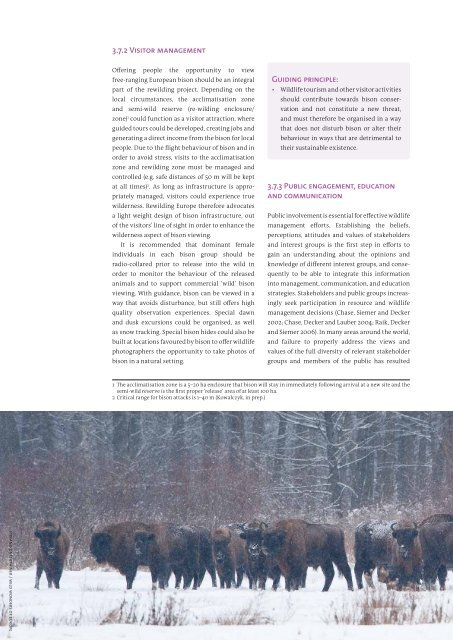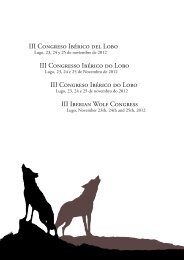Bison-Rewilding-Plan-2014
Bison-Rewilding-Plan-2014
Bison-Rewilding-Plan-2014
- No tags were found...
Create successful ePaper yourself
Turn your PDF publications into a flip-book with our unique Google optimized e-Paper software.
3.7.2 Visitor managementOffering people the opportunity to viewfree-ranging European bison should be an integralpart of the rewilding project. Depending on thelocal circumstances, the acclimatisation zoneand semi-wild reserve (re-wilding enclosure/zone) 1 could function as a visitor attraction, whereguided tours could be developed, creating jobs andgenerating a direct income from the bison for localpeople. Due to the flight behaviour of bison and inorder to avoid stress, visits to the acclimatisationzone and rewilding zone must be managed andcontrolled (e.g. safe distances of 50 m will be keptat all times) 2 . As long as infrastructure is appropriatelymanaged, visitors could experience truewilderness. <strong>Rewilding</strong> Europe therefore advocatesa light weight design of bison infrastructure, outof the visitors’ line of sight in order to enhance thewilderness aspect of bison viewing.It is recommended that dominant femaleindividuals in each bison group should beradio-collared prior to release into the wild inorder to monitor the behaviour of the releasedanimals and to support commercial ‘wild’ bisonviewing. With guidance, bison can be viewed in away that avoids disturbance, but still offers highquality observation experiences. Special dawnand dusk excursions could be organised, as wellas snow tracking. Special bison hides could also bebuilt at locations favoured by bison to offer wildlifephotographers the opportunity to take photos ofbison in a natural setting.Guiding principle:• Wildlife tourism and other visitor activitiesshould contribute towards bison conservationand not constitute a new threat,and must therefore be organised in a waythat does not disturb bison or alter theirbehaviour in ways that are detrimental totheir sustainable existence.3.7.3 Public engagement, educationand communicationPublic involvement is essential for effective wildlifemanagement efforts. Establishing the beliefs,perceptions, attitudes and values of stakeholdersand interest groups is the first step in efforts togain an understanding about the opinions andknowledge of different interest groups, and consequentlyto be able to integrate this informationinto management, communication, and educationstrategies. Stakeholders and public groups increasinglyseek participation in resource and wildlifemanagement decisions (Chase, Siemer and Decker2002; Chase, Decker and Lauber 2004; Raik, Deckerand Siemer 2006). In many areas around the world,and failure to properly address the views andvalues of the full diversity of relevant stakeholdergroups and members of the public has resulted1 The acclimatisation zone is a 5–20 ha enclosure that bison will stay in immediately following arrival at a new site and thesemi-wild reserve is the first proper ‘release’ area of at least 100 ha.2 Critical range for bison attacks is 1–40 m (Kowalczyk, in prep.)STEFANO UNTERTHINER / WILD WONDERS OF EUROPE38



